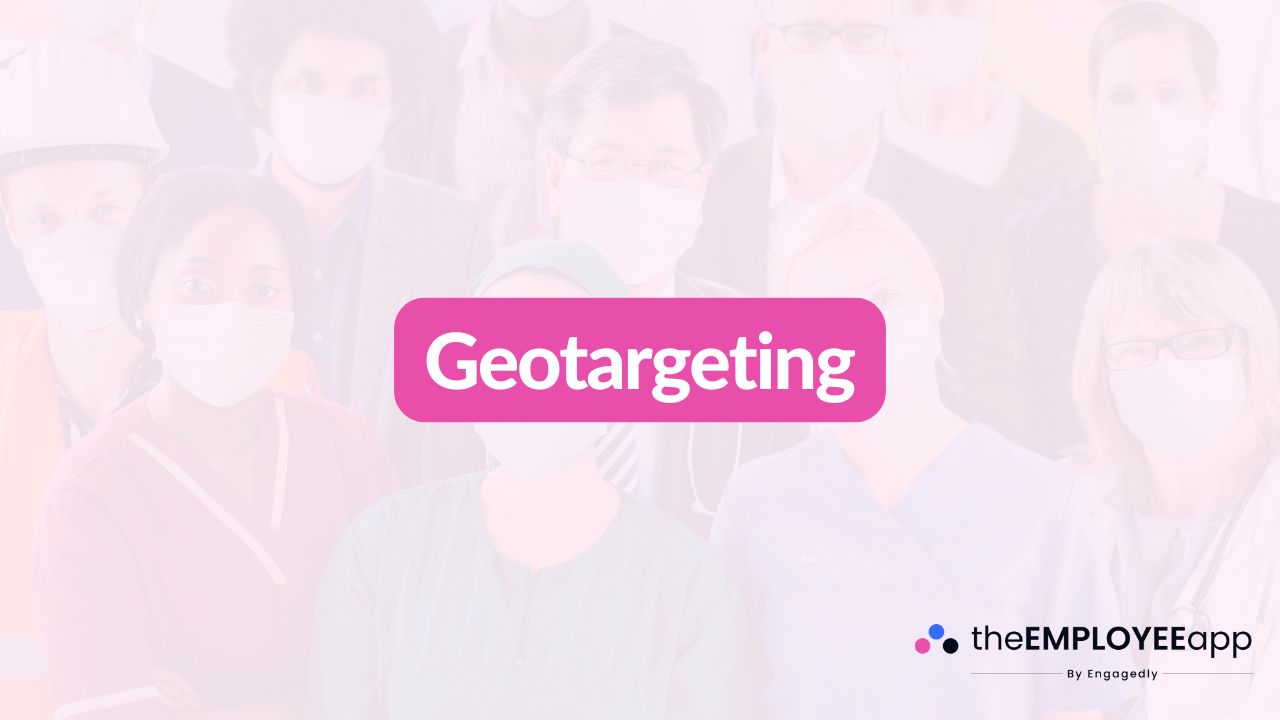
Geotargeting
Geotargeting is the practice of delivering content, messages, or resources to users based on their geographic location. By using location data such as country, region, city, or even proximity to a specific workplace, organizations can ensure that communication is relevant and timely. Instead of sending the same message to everyone, geotargeting makes it possible to personalize communication for employees or audiences in a specific area.
Why Geotargeting Matters
In the workplace, employees often span multiple locations, facilities, or branches. Sending the same communication to all employees, regardless of their location, can lead to confusion or irrelevant messages. For example, a maintenance update at one office may not apply to workers in another region. Geotargeting ensures that employees only receive updates that apply to them. This approach reduces noise, increases trust in company communication, and makes every update more actionable.
How Geotargeting Works
Geotargeting uses data about a user’s location, which can come from IP addresses, mobile devices, GPS signals, or designated group settings in a communication platform. Administrators can create audience groups based on location and send messages tailored to that group. For example, an organization might send weather-related emergency alerts to employees in one city while sending different operational updates to a facility in another region. By connecting communication to physical geography, organizations make their messages more precise and effective.
Benefits of Geotargeting
Relevance: Messages are directly tied to an employee’s workplace or region.
Efficiency: Cuts down on unnecessary communication for employees outside the affected area.
Improved safety: Enables delivery of urgent alerts in specific locations, such as during emergencies or severe weather.
Enhanced employee engagement: People are more likely to pay attention when messages clearly apply to them.
Localized culture and inclusion: Allows companies to share community-specific events, recognition, or updates that foster connection.
Consistency across regions: Ensures each location gets accurate and timely information tailored to their needs.
Examples of Geotargeting in Action
Emergency notifications: Sending urgent alerts only to employees in a region impacted by severe weather.
Facility updates: Communicating building maintenance schedules only to staff who work in that facility.
Local HR updates: Sharing policy reminders or benefits information that applies to employees in one state or country.
Event promotion: Inviting employees to a company event happening only in their city.
Shift changes: Notifying employees at a certain site about scheduling changes relevant only to them.
These examples show how geotargeting supports clarity and ensures the right information reaches the right audience.
Best Practices for Geotargeting
Define clear location groups: Segment employees by office, branch, or geographic region.
Use accurate data: Ensure employee locations are kept up to date for reliable targeting.
Prioritize relevance: Only send location-based messages that truly matter to that group.
Be mindful of inclusivity: While targeting ensures relevance, avoid excluding broader company updates everyone should know.
Automate where possible: Use communication tools that allow for scheduled or automated geotargeting based on location data.
The Role of Geotargeting in Employee Communication
For organizations with distributed or frontline workforces, geotargeting is invaluable. Deskless employees may not have constant access to email or corporate intranets, but they do need timely updates relevant to their specific workplace. By delivering content based on geography, companies ensure critical information is seen and acted on without overwhelming employees in other regions. It also builds trust—when employees consistently receive communication that applies to them, they are more likely to pay attention.
The Future of Geotargeting
As workplace technology evolves, geotargeting is becoming more sophisticated. Modern communication platforms are incorporating advanced location detection and automation, allowing companies to instantly notify the right people at the right place and time. In the future, geotargeting may integrate with AI to predict which groups need certain updates and even optimize the timing of delivery. This shift will further streamline how organizations connect with employees in different regions.
Conclusion
Geotargeting is a powerful tool that makes communication more relevant, efficient, and engaging by focusing on location. By ensuring that messages reach only the employees who need them, organizations reduce noise, increase trust, and improve workplace alignment. Whether it’s for safety alerts, facility updates, or regional announcements, geotargeting helps organizations deliver the right message to the right people at the right time.
